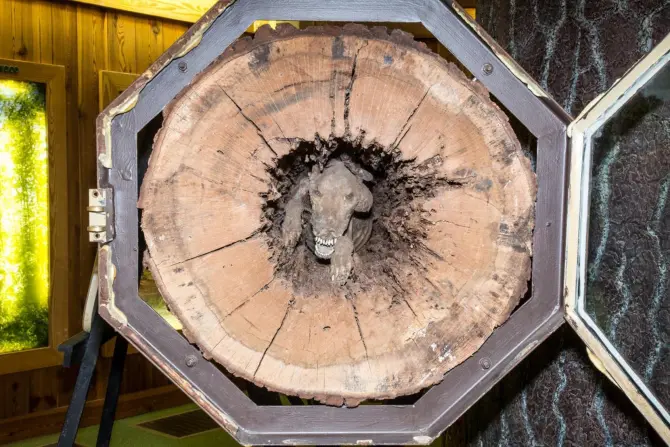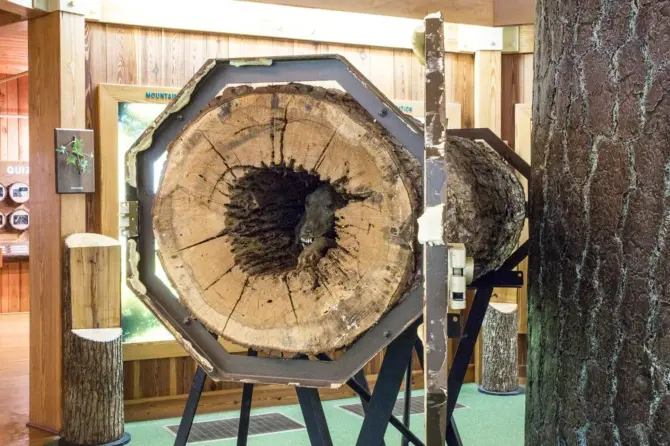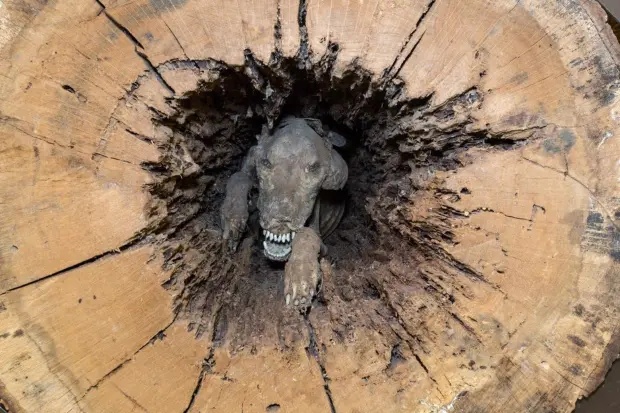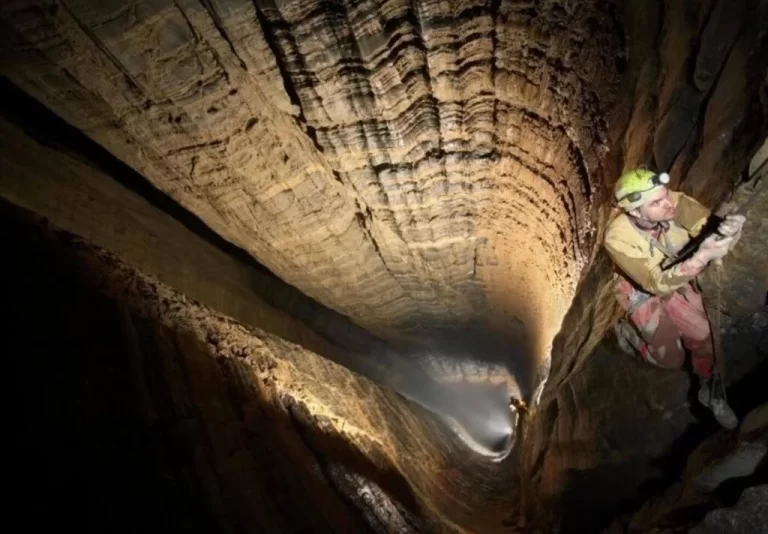Mummified dog found inside a tree trunk 20 years after it got wedged in while ‘chasing a raccoon’
The hunting dog, aptly named Stuckie, was discovered in a hollow stretch 28ft up by loggers chopping up the chestnut oak in Georgia, US, in 1980.
Experts believe the dog had likely been chasing small game when it got stuck in the tree gap about 20 years earlier.
Instead of sending the tree to the sawmill, workers from Kraft Corporation donated it to Forest World, a tree museum in Waycross, Georgia.
Museum staff think the dog’s body mummified because an upward draft through the hollow tree created a chimney effect, carrying away the scent that would normally attract insects and other organisms.
The tree provided dry conditions, and the oak’s tannic acid, which absorbs moisture and dries out its surroundings, helped to harden the animal’s skin.

**Meet “Stuckie” — The Mummified Dog Found in a Tree Trunk**
In 1980, a group of loggers from the Georgia Kraft Company, working in Jasper, Georgia, made a startling discovery. They were cutting down a chestnut tree when they noticed that the trunk was unusually light and hollow. As they brought the tree down, they were met with a shocking sight inside the hollow trunk: the mummified remains of a dog.
The dog, later named Stuckie, appeared to be growling, its sharp teeth and long snout visible. Despite its frightening appearance, the dog was not alive but perfectly preserved, a canine time capsule from a bygone era. Intrigued by their find, the loggers decided to set the tree trunk aside rather than cutting it for pulp, hoping someone could investigate the mystery.
The chestnut tree, known for its rapid growth and commercial value, had an interesting characteristic that played a crucial role in preserving Stuckie. The wood of the chestnut tree contains tannin, a natural desiccant that absorbs moisture. This prevented the microbes that usually cause decomposition from thriving, thus mummifying the dog. Additionally, the hollow tree acted like a chimney, drawing air upward and preventing scavengers from smelling the deceased animal inside.
Biologists and anthropologists, including Christina Kilgrove from the University of West Florida, studied the mummified remains and confirmed that the dog had been naturally preserved. They explained how the unique conditions inside the chestnut tree prevented the usual decay process.
But how did Stuckie end up inside the tree? Experts believe that the dog, about four years old at the time, was a hunting dog chasing prey such as a raccoon or squirrel. In his pursuit, he likely climbed into the tree and became stuck about 28 feet up, eventually dying of starvation.
A year after the discovery, the Southern Forest World museum in Waycross, Georgia, opened its doors in 1981. The museum, dedicated to the forestry industry of the southeastern United States, received the tree trunk with Stuckie’s remains. Stuckie quickly became a central exhibit, drawing attention from visitors and becoming a mascot for the museum.
For years, the dog was simply known as “the mummified dog.” It wasn’t until 2002 that the museum held a naming contest. Among the suggested names were “Chipper” and “Dogwood,” but “Stuckie” won. The name was inspired by Stuckey’s convenience stores, known for their pecan logs, though the spelling was slightly altered to avoid trademark issues.
Today, Stuckie remains a popular exhibit at the Southern Forest World museum. Visitors can see him prominently displayed in the museum’s central rotunda, surrounded by various tree specimens like cypress, oak, and pine. Stuckie’s story is a fascinating blend of natural history and mystery, preserved for future generations to marvel at.
If you ever find yourself in Waycross, Georgia, a visit to Southern Forest World to see Stuckie, the mummified dog, is a must.
———————————–
The low-moisture environment stopped microbial activity, preventing decay and preserving Stuckie’s body in remarkably good condition.
Brandy Stevenson, the manager of Forest World, told Roadside America, “People always ask me, ‘How did he get in there?’ And I always say, ‘Well, he was a hound dog. Maybe he was after a raccoon.’ And then they’ll say, ‘Poor old thing. I feel so sorry for him.'”
Stuckie, named after a 2002 contest, can be seen at the Southern Forest World Museum and Environmental Center in Waycross, Georgia.

Also Read:
Leonardo da Vinci and the “satellite” map made in 1502
The biggest horse ever recorded in history was Sampson, Who was from Shire breed






